Strategies to Protect Birds from Cats at Home
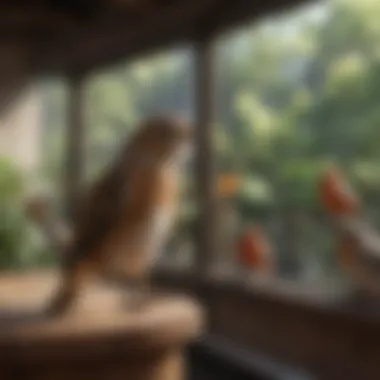
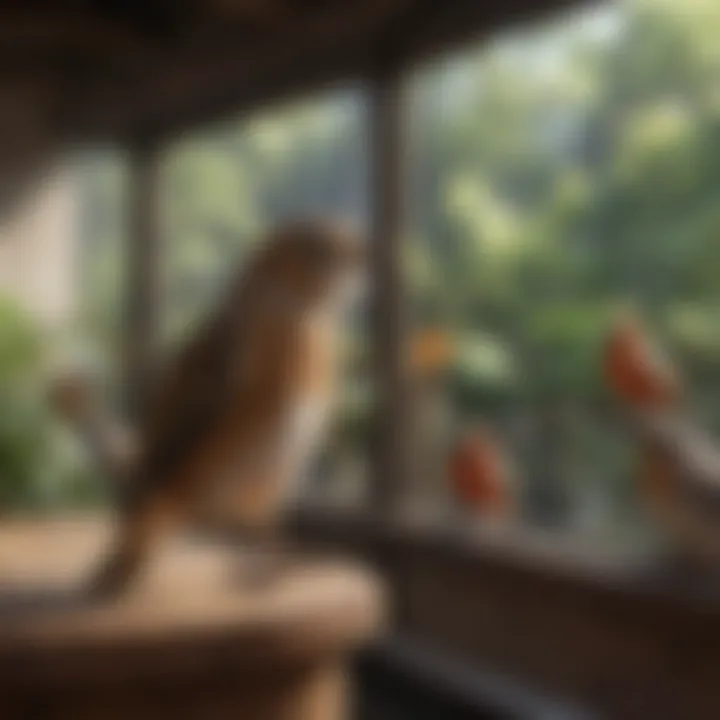
Intro
Keeping pet birds is a joy that comes with its own set of challenges, one of the most pressing being the risk posed by household cats. Cats are natural predators, often driven by instinct to stalk, pounce, and play, which can make them potential threats to our delicate feathered friends. To ensure the safety of birds, pet owners need to adopt strategies that recognize cat behavior while safeguarding avians. In this comprehensive guide, we will explore effective methods designed to help pet owners establish a secure environment for their birds and reduce the risk of feline encounters.
Care Tips
Creating a safe haven for your birds starts with proper care routines and environmental adjustments. By understanding how to structure the daily lives of your pets, you can significantly reduce the risks associated with cohabitating cats.
Daily Care Routines
A consistent daily routine not only keeps birds happy but also minimizes the chance of falling into dangerous situations. Start by feeding your birds at the same time every day, as this establishes a sense of stability. Always be mindful of the timing and locations during feeding. Close the birds' cage when you're ready for feeding, preferably in an area safely away from your cat's reach. It's also prudent to monitor any interaction between your cat and bird closely.
Cage Setup and Maintenance
An ideal cage setup is crucial. Choose a sturdy cage designed specifically for your bird's size and species, preferably one with small bars to prevent any escape attempts. Position the cage high up, as cats are less likely to leap for something they can’t easily reach. Maintain a clean space; ensure perches, toys, and bowls are free from dirt or food particles that attract not just birds but also feline attention.
Hygiene and Cleaning Practices
Regular cleaning is not just about keeping cages tidy; it also discourages unwanted attention from cats. Use pet-safe cleaning products to wipe down surfaces regularly. Periodically deep clean the cages while your birds are safely secured in another room away from the clutches of curiosity.
Seasonal Care Adjustments
With changing seasons, the environment around your pets alters too. During spring and summer, windows might be open more often, which can lead to unexpected encounters. Ensure screens are secured. It might also be worth investing in window guards or reflective bird-safe films that prevent birds from getting too close to windows or balconies.
Behavioral Insights
Understanding your pets’ day-to-day behaviors can go a long way in preventing risky situations. Birds communicate through their body language, which may indicate anxiety or distress if a cat is nearby.
Understanding Bird Body Language
Birds often display signs when feeling threatened—ruffled feathers, rapid movements, or sudden silences. Being attuned to these shifts allows you to intervene promptly before any mischief occurs.
Common Behavioral Issues and Solutions
Some birds might become more anxious when there’s a cat around. Behavior like feather plucking could indicate stress. If this happens, consult with avian veterinarians. It’s paramount to remedy such behavior through gradual exposure and ensuring comfort.
Positive Reinforcement Techniques
Encouraging positive relationships among pets through reward systems works wonders. When your cat ignores your birds, rewarding them with treats can strengthen that behavior. This trick can change a cat’s paradigm of viewing birds as playthings.
Social Interaction Needs
Birds are social creatures. Providing them with consistent companionship, whether that be from humans or even other birds, can lessen stress and create a more relaxed atmosphere, which is critical when cats are around. At the same time, allowing the cat some playtime and exercise can divert attention from the birds, balancing the pet dynamics.
Ending
In engaging with these care tips and behavioral insights, bird owners can create an environment that promotes safe boundaries between their birds and cats. This balanced approach not only ensures the safety of avian companions but also enhances the overall atmosphere of the home. With vigilant observation and strategic planning, pet parents can continue to enjoy their unique interactions while maintaining a peaceable coexistence among housemates.
Understanding the Relationship Between Cats and Birds
Understanding the relationship between cats and birds is crucial for anyone who hopes to foster a safe environment for their feathered friends. It's not just about keeping the birds safe; it’s about realizing the dynamics at play when these two species share a living space. This understanding provides insight into the natural behaviors of both animals, and helps us take preventive measures to ensure that interactions do not turn dangerous.
Cats, by nature, are hunters. Their instincts drive them to stalk, chase, and capture prey, which often includes small animals like birds. This instinctual behavior poses a significant risk to pet birds, as it's not merely a playful gesture when a cat pounces—it's a hardwired response to their surroundings.
"Understanding the instinctual behaviors of both cats and birds helps in creating safer living environments for all pets in the home."
Ultimately, knowing how cats view birds can help pet owners take steps to prevent any harmful encounters. In this article, we'll explore various strategies that can aid in maintaining a peaceful coexistence.
Natural Instincts of Cats
Cats are innate hunters, a trait that goes back thousands of years. When we think about a cat's behavior, we often notice their fascination with movement. A fluttering bird captures their attention like a moth to a flame. Their eyes widen, muscles tense, and they might crouch low, signaling a predatory focus.
It’s important to grasp that for cats, this isn't just play. It's an expression of their instincts—developed over time to survive in the wild. Felines employ stealth as they stalk, using their keen sense of hearing and sight to track their target. This typical behavior, although adorable when observing your own cat, can create a perilous situation for pet birds.
To counter this, recognizing these instincts enables bird owners to implement proactive measures that can divert this feline interest away from their birds. For instance, providing your cat with plenty of engaging toys and activities can help redirect their focus away from the birdcage and into play.
Birds as Prey – An Overview
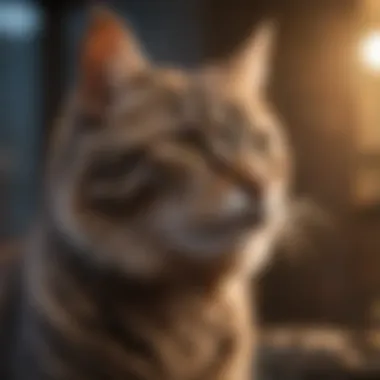
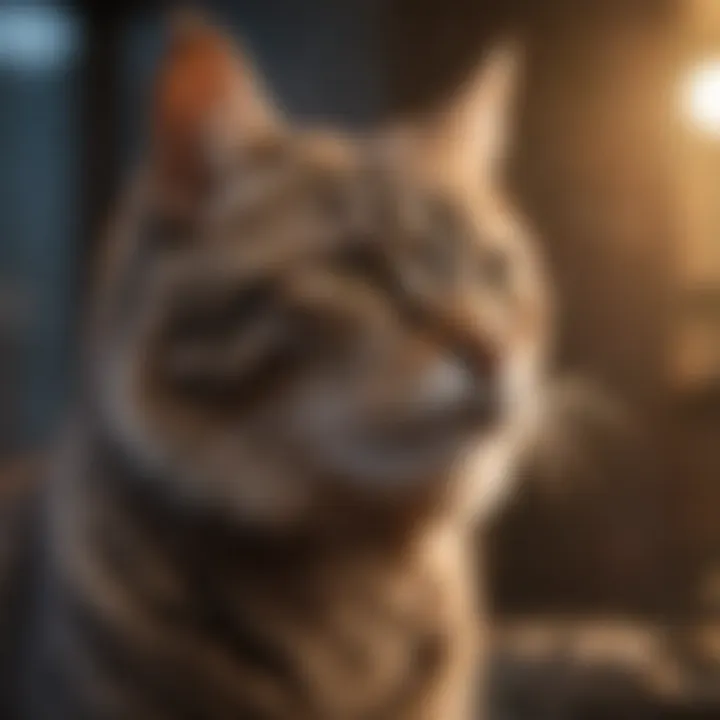
Birds, particularly smaller species, find themselves on the bottom of the food chain. Their natural defense mechanisms include flying away, hiding, or making quick movements to evade predators. However, these strategies aren't foolproof against a cat that has honed its skills over years to capture such creatures.
When we discuss birds as prey, it's vital to acknowledge the vast array of species and their varied responses to threats. Some birds may exhibit fearlessness, while others are more skittish and stress-prone. Their instincts lead them to hide or stay quiet, making them vulnerable in an open setting when faced with a curious cat.
Hence, creating an ideal environment for birds must consider these instincts. An adequately designed perch or a hidden nook within their enclosure can greatly benefit them, allowing them to escape or at least shield themselves from potential dangers.
In summary, understanding both the hunting instincts of cats and the inherent vulnerabilities of birds lays the groundwork for pet owners to take appropriate actions. Through this understanding, we can implement effective strategies that protect our cherished avian companions while maintaining a harmonious home.
Identifying Risks to Pet Birds
To ensure the safety of your pet birds, it's crucial to identify the various risks they face, especially from household cats. Through understanding the dynamics of cat behavior and the specifics of your environment, you can tailor your approach to effectively shield your feathered companions from harm. Assessing these risks not only protects your birds but also aids in fostering an overall harmonious atmosphere within your home. This section will delve into common feline behaviors that pose threats and will guide you in evaluating and modifying your living space accordingly.
Common Cat Behaviors Around Birds
Cats are notoriously curious creatures, and their instincts often lead them into precarious situations—particularly when it comes to birds. Here are a few behaviors cat owners should be wary of:
- Pouncing and Stalking: Cats have a natural hunting instinct, driving them to stalk and pounce on moving objects. Unfortunately, this instinct may also target pet birds, especially if they are flying or fluttering in their cages.
- Bating and Bumping: Cats engage in play that mimics their hunting techniques. This can involve batting at or bumping into the bird's cage, which can be both alarming for the bird and it can risk structural integrity of enclosure.
- Vocalizations: Many cats use sounds—like chattering or meowing—to entice or communicate with potential prey. These noises can provoke stress in birds, even from a distance.
It’s essential to monitor these behaviors consistently, as they will inform how you manage the interactions between your pets. Being proactive about recognizing these patterns can mitigate the risks effectively.
Evaluating the Environment for Safety
An unsafe environment is often a silent threat to pet birds. By closely scrutinizing your home, you can make strategic changes to enhance safety for your birds. Here are several considerations:
- Cage Placement: Position your bird's cage in a secure area, possibly higher up and away from lurking cats. A location where cats naturally do not venture can serve as a buffer zone.
- Secure Entrances: Ensure that any doors or windows allowing birds to fly freely are equipped with screens. Not only does this prevent birds from escaping, but it also keeps cats at bay.
- Avoiding Clutter: Cats love to explore, and clutter can provide them with hiding spots to ambush unsuspecting birds. Maintain tidy spaces around your bird's area to reduce these risks.
- Creating Barriers: Utilizing gates, fences, or even strategically placed furniture can help form a physical barrier. This will limit the accessibility cats have to your birds’ domain while allowing for visibility.
"A secure home is one where every corner is pet-proofed, and every pet lives in harmony with others."
Creating a Safe Space for Birds
Creating a safe environment for pet birds is not just a matter of convenience; it’s a cornerstone of responsible pet ownership. Birds, by their very nature, are delicate creatures that require specific habitats to thrive. Meanwhile, household cats possess instincts that could put these feathered friends in danger. Designing spaces that cater to birds’ needs while simultaneously protecting them from feline curiosity is essential. It helps reduce stress levels for both species and promotes a peaceful coexistence in the home.
A carefully structured space for birds acts as a sanctuary that offers them not only safety but also stimulation and comfort. Moreover, it reinforces the idea that birds have their own territory - a crucial aspect in reducing unwanted encounters with cats. This article delves into the components that contribute to creating this protective sanctuary, focusing on both enclosures and designated areas within the home.
Ideal Bird Enclosures
Types of Enclosures
When we talk about bird enclosures, we think of a secure haven fitted to provide our feathered companions with safety and comfort. It’s crucial to consider various types of enclosures because they significantly influence how well the birds can thrive. Among the most popular choices are aviaries and cages designed specifically for their breed.
- Aviaries offer ample space for birds to fly around, mimicking a more natural environment.
- Cages, on the other hand, might be more portable and easier to manage but are generally smaller.
A key characteristic of aviaries is that they allow for vertical space, which is crucial for birds that love to climb. Many birds find them a happy digit place thanks to the spacious layout, which avoids the confinements associated with traditional cages. However, they often require more space in a home.
An enclosure isn’t just any four walls; it needs to be a mix of functionality and aesthetic appeal. Looks matter too, especially when that space is a part of your living area. Choose materials that are safe and durable, keeping in mind that some birds have a tendency to chew. Evaluating both the environment and the specific needs of the bird species can lead to more mindful decisions.
Size and Design Considerations
Size and design aspects are equally vital when constructing a cozy bird home. Each species has unique space requirements; some prefer to spread their wings wide, while others might be comfortable in snugger quarters.
Birds like parrots require spacious areas where they can hop around and flap their wings, while smaller species such as finches might do well in more compact habitats. A golden rule is to provide more space than needed; it’s easier to scale down a big space than to scale up a small one.
Moreover, the design must consider the placement of perches, toys, and food dishes, encouraging birds to engage in healthy behaviors. An optimally designed enclosure balances functional needs, like proper ventilation and easy access to feed and water, with features that encourage exploration. For instance, angular designs can be beneficial to mimic natural foliage, adding a bit of the outdoors into the mix.
Using a thoughtful approach ensures that the birds not only feel like they are safe but also engaged and content, augmenting their mental health and physical well-being. A poorly designed area can lead to stress and confusion, making it crucial to aim for a layout that promotes ease, safety, and enrichment.
Designated Bird Areas in the Home
A designated bird area within the home is as important as an enclosure. This area should be separate from where the cats roam freely, allowing birds both autonomy and security while providing a thoughtful approach to pet management. Many bird owners find that this setup considerably reduces the anxiousness that may arise when cats and birds are in close proximity, hence reducing the potential for mishaps.
Whether it’s a sun-soaked corner of the living room or a quiet nook in a home office, a bird area should have natural light, comfortable perches, and a selection of toys. This ensures that the birds have a safe place to thrive and play, so they feel like they're part of the household while staying protected from cats.
In summary, setting up an ideal environment for birds goes beyond simple cage placement; it intertwines with how thoughtful one is about their interaction with other pets. It is a win-win precarious balancing act that pays off in fostering both security and happiness.
Utilizing Deterrents Against Cats
Keeping cats away from pet birds is a multifaceted task, needing not only vigilance but also a thoughtful approach. Utilizing deterrents against cats is crucial as it directly affects the safety of your birds. By creating obstacles and employing strategies that shift a cat's focus away from its instinctual prey, you can ensure a more peaceful environment.
Physical Barriers and Their Efficacy


Physical barriers can effectively safeguard pet birds, working as the first line of defense. These barriers can be simple yet effective. For instance, installing bird netting or using wire mesh can prevent a curious cat from reaching an enclosure. However, you need to consider the strength and durability of these materials.
- Types of Barriers: Enclosures can vary widely from basic cages to intricate aviaries. Each varies in complexity and security features.
- Importance of Height: Birds are naturally inclined to fly or jump. Thus, having tall barriers can be more effective than shorter ones, keeping cats at bay.
- Accessibility Considerations: Ensure food and water access remains easy for the birds without allowing cats a chance to leap inside.
In essence, physical barriers not only act as a fence but also provide mental peace for bird owners. They need to be sturdy; otherwise, they won't hold up against a determined cat, who can be surprisingly agile.
Scent and Sound Deterrents
Scent and sound deterrents offer alternative methods to keep cats at a distance. Using these strategies can provide a less invasive way of maintaining a secure environment for your birds.
Using Scent-Based Deterrents
Scent-based deterrents exploit the olfactory sensitivities of cats, making them effective in discouraging unwanted behaviors. Certain scents are displeasing to felines, often causing them to shy away:
- Key Characteristics: Citrus and certain essential oils like lavender can be beneficial. Cats often find these scents distasteful.
- Application Methods: Spraying diluted mixtures near bird areas or integrating them into existing cat toys can redirect a cat's focus.
- Ease of Use: Scent-based deterrents are simple to apply and don't require much setup.
However, be mindful of your birds—some scents can be harmful or irritating to feathered friends. It’s crucial to ensure that whatever you use doesn’t put them at risk, maintaining a balance in ensuring safety.
Sound Devices to Deter Cats
Sound devices are another layer of protection, using auditory signals to create an unwelcoming atmosphere for cats. These can range from simple devices to more advanced options that appear in the pet care market:
- Key Characteristics: Many sound deterrents emit high-frequency sounds that only cats can hear. This can deter a cat from approaching the bird area without disturbing the birds themselves.
- Variety of Options: Options like motion-activated alarms can be especially effective by creating immediate feedback when a cat strays too close.
- User-Friendliness: Most sound devices are easy to install and can cover a broad area, providing assurance for your pets.
Nevertheless, it’s important to observe how your own birds react to the sounds. If the deterrent creates stress for your feathered companions, it's best to seek alternative solutions that keep them comfortable.
Important Reminder: Always ensure that any method of deterrent implemented prioritizes the well-being of both your birds and your cats, creating harmony in your home.
Training Techniques for Cats
Training techniques for cats are pivotal in fostering a peaceful home where both pets and owners can thrive. Often, cat owners underestimate the capability of cats to learn and adapt behaviors, believing them to be independent creatures who do as they please. In reality, a structured training approach can help cats understand boundaries, especially in homes where they coexist with other pets, like birds. The essence of training lies in communication, which is key to any successful relationship between humans and animals.
Introducing Positive Reinforcement
Positive reinforcement is a strategy that uses rewards to encourage desired behaviors. For instance, when a cat interacts calmly around birds without showing predatory instincts, rewarding them with a treat can reinforce this behavior. The goal is to create a scenario where cats associate the presence of birds with positive outcomes. This can be particularly effective if the rewards are something the cat values highly, like their favorite treat or playtime with a feather toy.
- Specific Benefits:
- Enhances the cat's ability to learn through immediate feedback.
- Strengthens the bond between pet and owner, fostering trust.
- Deters negative behaviors without using harsh methods.
Incorporating this method requires patience. It's not a one-and-done scenario but rather a consistent practice over time. Keep sessions short and engaging; 10-15 minutes can be enough to keep the cat's attention without overwhelming them.
Redirecting Feline Attention
Redirecting feline attention is another effective technique for training. This involves steering your cat away from their instinct to stalk or pounce on birds, instead guiding their focus toward appropriate activities. For example, if your cat starts to show interest in the birds, you can gently distract them by using a toy or engaging them in a different play activity.
Consider these strategies for redirecting attention:
- Creating a Cat-Friendly Environment:
- Using Interactive Play:
- Scheduled Playtime:
- Establish play zones with various toys that spark curiosity and engagement.
- Use vertical spaces like shelves or cat trees to create an area where your cat can explore and play freely.
- Feather wands and laser pointers can shift their focus from the birds to a more suitable target.
- A dedicated playtime can help burn off excess energy, making cats less inclined to chase birds when they are calm.
Redirecting attention not only prevents adverse interactions but also enhances your cat’s overall well-being. It fosters a sense of security, reducing the likelihood of stress-related behaviors that could arise from frustration.
Remember, a well-stimulated cat is less likely to view birds as prey. By integrating these training techniques, the coexistence of cats and pet birds can be managed in harmony, ensuring that both animals feel safe and at ease in their environment.
Monitoring Interactions Between Cats and Birds
Keeping cats and pet birds under the same roof can be quite the balancing act. One of the best steps you can take as a pet owner is to intricately monitor their interactions. This isn’t just about ensuring that no feathers are ruffled; it’s a proactive approach to safeguarding the well-being of your avian companions. By keeping a sharp eye on their encounters, you can spot any signs of stress or aggressive behaviors early, thus preventing any unfortunate incidents.
More importantly, monitoring these interactions allows you to understand the dynamics at play. Each pet has its own temperament and behaviors. Observing how your cat reacts to the presence of birds can provide invaluable insight. You not only protect your feathered friend but also gain critical knowledge about your cat's tendencies.
Setting Up Supervised Visits
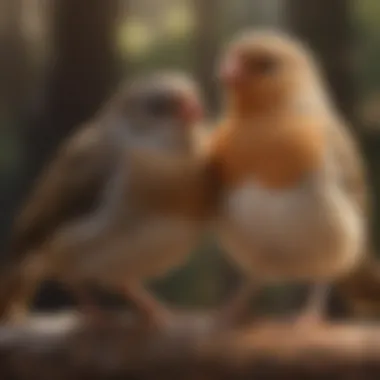

The cornerstone of managing the tangled relationship between cats and birds rests upon setting the right ground rules. Supervised visits are non-negotiable when introducing your cat to your pet birds. Regardless of how trustworthy you believe either pet to be, never chance it without oversight. These supervised visits should be structured and intentional.
- Create a Safe Environment: Choose a space where the bird feels secure, away from usual cat hiding spots. Utilizing a room with bird-safe screens can be quite effective.
- Short Sessions: Start with brief encounters to gauge reactions. Even a few minutes can provide enough insight.
- Gradual Exposure: Slowly increase the duration of visits, always paying close attention to body language and emotions of both pets.
- Use Positive Reinforcement: Reward calm behavior from both the cat and the bird. Treats and praise can act as large motivators.
Take a moment to think about your own reaction in similar circumstances. Imagine a new environment full of distractions—some might play nice, while others view it as a competition. Your cat’s instincts can kick in unpredictably, so it’s essential to remain vigilant.
"Monitoring interactions enables active problem-solving, minimizing risk and promoting harmony among pets."
Observing Behavior Patterns
Simply introducing cats to birds isn’t the sole focus; it’s about delving into the nuances of behavior. You need to pay attention to how these two species interact over time. Keeping a journal can be handy. This can help track patterns in behavior, noting any instances of aggression or stress, which can happen in the blink of an eye.
- Signs of Anxiety in Birds: Watch for signs like puffed feathers, rapid movements, or erratic vocalizations. These behaviors are clear cut signals that your bird may be feeling threatened.
- Cat Behavior: Is your cat overly focused on the bird, or does it ignore it completely? A well-flaked personality might exhibit curious behavior, while a more driven cat could be fixated. The latter definitely signals work that needs to be done.
Tracking these behaviors isn’t just for establishing a routine—it's vital for predicting outcomes in interactions. The insights gleaned can inform decisions for adjusting safety measures or reinforcing boundaries in the future.
Ultimately, understanding the intricate dance between cats and birds can be quite rewarding. A little patience goes a long way in fostering a peaceful coexistence in your home.
Choosing Compatible Pets
When owning both cats and birds, understanding their compatibility is crucial for ensuring safety and harmony in your home. It’s not just about coexisting; it’s about creating an environment where both species can thrive. Choosing the right pets involves assessing the characteristics of both the bird and cat and making informed decisions that benefit their well-being.
Selecting Bird Species
Species with Defensive Behaviors
One of the primary considerations when selecting bird species is their defensive behaviors. Certain types of birds possess natural instincts to protect themselves, often displaying assertiveness in the face of a threat. For example, larger parrot species such as the African Grey or Amazon are known to exhibit robust behaviors that can deter potential foes. These birds aren't scared easily and often vocalize loudly when they sense danger, which can be quite helpful in a mixed-pet household.
Their key characteristic lies in their size and assertive nature. Compared to smaller birds, these species are less likely to fall victim to a cat’s instinctual hunting. A benefit of owning these types of birds is that they can often hold their own, using their beaks and agility to fend off intruders, rather than relying solely on flight.
However, there are disadvantages too. Larger bird species can be demanding in terms of care, requiring proper training and stimulation to thrive. If their environment isn’t adequately enriched, they might become bored, which can also lead to unwanted behaviors.
Calm Temperament Considerations
The temperament of the bird species is another critical factor. Birds with calm dispositions, such as budgerigars or canaries, can make excellent companions in multi-pet situations. Their gentle nature can promote a peaceful environment, reducing the likelihood of stress for both birds and cats. A budgie, for instance, is small and often non-threatening, which might keep a curious cat at bay.
Their defining trait is sociability, as they tend to coexist well with other pets if introduced correctly. This can be beneficial for reducing the tension that sometimes arises between different species. However, it’s essential to note that calm birds can sometimes be perceived as easy targets, especially by more aggressive or playful cats.
Balancing these considerations means realizing that an ideal bird for your home should have both a compatible temperament and defensive behaviors, allowing for a blend of peace and protection.
Assessing Cat Temperament
Understanding the temperament of your feline companions is just as vital. Not all cats are born hunters; some might have a more laid-back attitude toward the world around them. Look out for signs like how they interact with toys or other pets. A cat that shows little interest in chasing or playing vigorously might be a more suitable companion in a household that includes pet birds.
A key trait to observe in a cat is their overall curiosity level. Some cats can be overly curious, which often leads to them viewing birds as playthings rather than companions. Additionally, a history of aggressive behavior towards small animals would raise red flags. However, if a cat demonstrates tolerance and a calm demeanor, this can go a long way in creating a peaceful coexistence.
Keep in mind that monitoring interactions and making gradual introductions can help ensure that both your pets feel secure in their environment.
The assessment of both bird and cat temperaments requires time and patience, but by understanding their behaviors and tendencies, you create a more balanced lifestyle for all family members.
Culmination: Maintaining a Harmonious Home
In the world of pets, achieving a peaceful coexistence between cats and birds is not only a goal for many pet owners, it's essential for the well-being of both species. Understanding the nature of each animal, along with adopting appropriate strategies, is crucial for fostering an environment where both can thrive without fear or aggression. This article has explored numerous aspects of keeping your feathered friends safe from feline curiosity. The importance of structured preventive measures cannot be overstated, as they directly contribute to the safety, health, and emotional stability of your pets.
When applying the insights shared in this article, pet bird owners, aspiring bird parents, and breeders alike can rest assured that they are creating secure living conditions. Building safe spaces for birds, utilizing deterrents, and monitoring interactions are just some of the strategies highlighted. Each measure plays a vital role in how effectively we can maintain this equilibrium in our living spaces.
Additionally, keeping an eye on not only physical barriers but also emotional cues—like stress signals from both parties—further enriches the bond we have with our pets. It's about being proactive rather than reactive, allowing for a wonderful range of experiences between different species in the household.
"A harmonious home is built not just on love, but on understanding the needs of every member around you."
Recap of Safety Measures
To tie the loose ends, here's a summary of key safety measures discussed:
- Safe Enclosures: Select bird cages that are sturdy and secure, providing ample space for your birds to feel comfortable. Make sure the design deters cats from accessing them easily.
- Scent Deterrents: Use fragrances cats usually dislike, such as citrus or mint, around areas where birds are kept.
- Sound Devices: Install devices that emit sounds or frequencies that are unpleasant for cats but harmless to birds, helping to keep them at bay.
- Supervised Interactions: Whenever cats and birds are in the same space, supervision is a must to prevent unexpected behaviors.
- Positive Reinforcement for Cats: Reward your cat when it shows interest in its toys instead of the birds.
Taking these precautions not only secures the safety of your pets but also allows you, as a pet owner, to enjoy the unique companionship both species can offer.
Future Considerations for Pet Owners
As you move forward with your pet ownership journey, consider the following future-oriented tips:
- Research Different Bird Species: Some species may be more resilient than others when sharing space with cats; understanding their behaviors can inform your choices.
- Ongoing Training for Cats: Continue to reinforce positive behaviors in your cat while discouraging any aggression or over-enthusiasm towards the birds.
- Adaptation Based on Age: If your pets age, consider that their interactions might change, and be ready to adjust your strategies to keep them comfortable and safe.
- Community Engagement: Joining online forums such as those on, Reddit or Facebook can provide additional support and insights from fellow pet owners, enriching your understanding of how to manage a multi-pet home.
In the end, maintaining a harmonious home is an ongoing journey filled with learning, patience, and dedication to your beloved companions. By continuously adapting and implementing effective strategies, the bond between your cats and birds can flourish, ensuring a safe and joyful environment for everyone.















